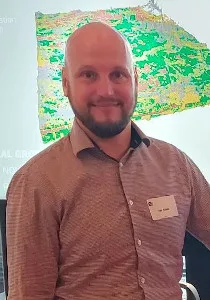
I am geoscientist specialized in the study of human-induced land subsidence in the Netherlands, affiliated to the Dutch research institute TNO, which comprises our national geological survey. In this role, I typically operate on the intersection between academics, industry, and government. My main specialism is human-induced subsidence in shallow soft soils, primarily peat-rich areas within the coastal plain of the Netherlands. However, I am highly interested new frontiers of land subsidence, and therefore involved in developing new methodologies, identifying new sources of subsidence, and studying the effects of subsidence on the built environment. This is exemplified by current research projects, which comprises a.o. disentangling of shallow soft soil related subsidence from deep subsidence by hydrocarbon extraction, studying the effects of shallow heat storage on subsidence in urban areas, linking subsidence to building damage, and deploying geophysics to quantify subsidence processes induced by drought. Furthermore, I operate as a business-to-business consultant regarding subsidence prone infrastructural works of major Dutch gas pipeline- and railway companies. I obtained my B.Sc. (2010) and M.Sc. (2012) in Earth Sciences from VU University Amsterdam. I received my Ph.D. (2017) in Physical Geography from Utrecht University, in collaboration with TNO.
- Candela T. & Koster K. (2022). The many faces of anthropogenic subsidence. Science 376, p. 1381-1382
- Candela T., Chitu, A.G., Peters, E., Pluymaekers, M., Hegen, D., Koster K. & Fokker, P.A. (2022). Subsidence induced by gas extraction: a data assimilation framework to constrain the driving rock compaction process at depth. Frontiers in Earth Science 10, p. 1-18
- Fokker, P.A., Gunnink, J., Koster, K. & De Lange, G. (2019). Disentangling and parameterizing shallow sources of subsidence: application to a reclaimed coastal area, Flevoland, the Netherlands. Journal of Geophysical Research: Earth Surface 124, p. 1099-1117
- Koster, K., Stafleu, J. & Stouthamer, E. (2018). Differential subsidence in the urbanised coastal-deltaic plain of the Netherlands. Netherlands Journal of Geosciences 97, p. 215-227
- Koster, K., Cohen, K.M., Stafleu, J. & Stouthamer, E. (2018). Using 14C-dated peat beds for reconstructing subsidence by compression in the Holland coastal plain of the Netherlands. Journal of Coastal Research 24, p. 1035-1045
- Koster, K., Stafleu, J., Cohen, K.M., Stouthamer, E., Busschers, F.S. & Middelkoop, H. (2018). Three-dimensional distribution of organic matter in coastal-deltaic peat: Implications for subsidence and carbon dioxide emissions by human-induced peat oxidation. Anthropocene 22, 1-9
- Koster, K., De Lange, G., Harting, R., De Heer, E., Middelkoop, H. (2018). Characterizing void ratio and compressibility of Holocene peat with CPT for assessing coastal-deltaic subsidence. Quarterly Journal of Engineering Geology and Hydrogeology 51, p. 210-218
- Koster, K., Erkens, G. & Zwanenburg, C. (2016). A new soil mechanics approach to quantify and predict land subsidence by peat compression. Geophysical Research Letters 43, p. 10792-10799
